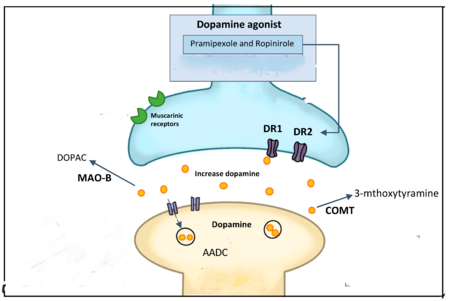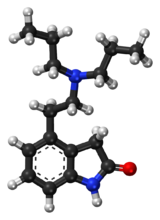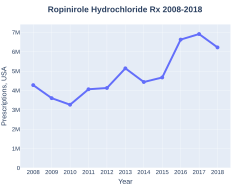Ropinirole
| |||
| Names | |||
|---|---|---|---|
| Trade names | Requip, Repreve, Ronirol, others | ||
| |||
| Clinical data | |||
| Pregnancy category |
| ||
| Routes of use | By mouth | ||
| Defined daily dose | 6 mg[1] | ||
| External links | |||
| AHFS/Drugs.com | Monograph | ||
| MedlinePlus | a698013 | ||
| Legal | |||
| Legal status |
| ||
| Pharmacokinetics | |||
| Bioavailability | 50%[2] | ||
| Metabolism | Liver (CYP1A2)[2] | ||
| Elimination half-life | 5-6 hours[2] | ||
| Chemical and physical data | |||
| Formula | C16H24N2O | ||
| Molar mass | 260.381 g·mol−1 | ||
| 3D model (JSmol) | |||
| |||
| |||
Ropinirole, sold under the brand name Requip among others, is a medication used to treat Parkinson's disease (PD) and restless legs syndrome (RLS).[3] In PD the dose needs to be adjusted to the effect and treatment should not be suddenly stopped.[3] It is taken by mouth.[4]
Common side effects include sleepiness, vomiting, and dizziness.[4] Serious side effects may include pathological gambling, low blood pressure with standing and hallucinations.[4][3] Use in pregnancy and breastfeeding is of unclear safety.[5] It is a dopamine agonist and works by triggering dopamine D2 receptors.[4]
It was approved for medical use in the United States in 1997.[4] It is available as a generic medication.[3] A month supply in the United Kingdom costs the NHS about £34 per month as of 2019.[3] In the United States the wholesale cost of this amount is about US$7.90.[6] In 2017, it was the 108th most commonly prescribed medication in the United States, with more than six million prescriptions.[7][8]
Medical uses
Ropinirole is prescribed for mainly Parkinson's disease, RLS and extrapyramidal symptoms. It can also reduce the side effects caused by selective serotonin reuptake inhibitors, including Parkinsonism syndrome as well as sexual dysfunction and erectile dysfunction caused by either SSRIs[9] or antipsychotics.
Dosage
The defined daily dose is 6 mg by mouth.[1] Ropinirole is available in various preparations, ranging from a 0.25 mg tablet to a 5 mg tablet. The primary reason is dose titration.
For Parkinson's disease, the maximum recommended dose is 24 mg per day, taken in three separate doses spread throughout the day. The maximum dose recommendations of ropinirole for subjects with end stage renal disease (ESRD) should be reduced by 25% compared with those recommended for subjects with normal renal function. A 25% dose reduction represents a more straightforward dosage regimen in terms of available tablet strength, compared with a 30% dose reduction.[10]
For RLS, the maximum recommended dose is 4 mg per day, taken 1 to 3 hours before bedtime. A 52-week open label study had a mean dosage of 1.90 mg, once daily 1 to 3 hours before bedtime.[11]
Side effects
Ropinirole can cause nausea, dizziness, hallucinations, orthostatic hypotension, and sudden sleep attacks during the daytime. Unusual side effects specific to D3 agonists such as ropinirole and pramipexole can include hypersexuality, punding and compulsive gambling, even in patients without a history of these behaviours.[12]
Ropinirole is also known to cause an effect known as "augmentation" when used to treat restless legs syndrome, where over time treatment with dopamine agonists will cause RLS symptoms to become more severe. This usually leads to constant dosage increases in an attempt to offset the symptom progression. Symptoms will return to the level of severity they were experienced at before treatment was initiated if the drug is stopped; however, both ropinirole and pramipexole are known to cause painful withdrawal effects when treatment is stopped and the process of taking a patient who has been using the medication long-term off of these drugs is often very difficult and generally should be supervised by a medical professional.[13]
Pharmacology

Ropinirole acts as a D2, D3, and D4 dopamine receptor agonist with highest affinity for D2. It is weakly active at the 5-HT2, and α2 receptors and is said to have virtually no affinity for the 5-HT1, GABA, mAChRs, α1, and β-adrenoreceptors.[15]
Ropinirole is metabolized primarily by cytochrome P450 CYP1A2 to form two metabolites; SK&F-104557 and SK&F-89124, both of which are renally excreted,[10] and at doses higher than clinical, is also metabolized by CYP3A4.
At doses greater than 24 mg, CYP2D6 may be inhibited, although this has been tested only in vitro.[2]
Society and culture
It is manufactured by GlaxoSmithKline (GSK), Mylan Pharmaceuticals, Cipla, Dr. Reddy's Laboratories and Sun Pharmaceutical. The discovery of the drug's utility in RLS has been used as an example of successful drug repurposing.[16]
Cost
A month supply in the United Kingdom costs the NHS about £34 per month as of 2019.[3] In the United States the wholesale cost of this amount is about US$7.90.[6] In 2017, it was the 108th most commonly prescribed medication in the United States, with more than six million prescriptions.[8][7]
-
Ropinirole costs (US)
-
Ropinirole prescriptions (US)
Lawsuits
In November 2012, GlaxoSmithKline was ordered by a Rennes appeals court to pay Frenchman Didier Jambart 197,000 euros ($255,824); Jambart had taken ropinirole from 2003 to 2010 and exhibited risky hypersexual behavior and gambled excessively until stopping the medication.[17]
References
- ↑ 1.0 1.1 "WHOCC - ATC/DDD Index". www.whocc.no. Archived from the original on 29 August 2021. Retrieved 6 September 2020.
- ↑ 2.0 2.1 2.2 2.3 Tompson, Debra J.; et al. (2007). "Steady-State Pharmacokinetic Properties of a 24-Hour Prolonged-Release Formulation of Ropinirole: Results of Two Randomized Studies in Patients with Parkinson's Disease". Clinical Pharmacokinetics. 29 (12): 2654–66. doi:10.1016/j.clinthera.2007.12.010. PMID 18201581.
- ↑ 3.0 3.1 3.2 3.3 3.4 3.5 British national formulary : BNF 76 (76 ed.). Pharmaceutical Press. 2018. pp. 419–420. ISBN 9780857113382.
- ↑ 4.0 4.1 4.2 4.3 4.4 "Ropinirole Hydrochloride Monograph for Professionals". Drugs.com. American Society of Health-System Pharmacists. Archived from the original on 7 March 2019. Retrieved 3 March 2019.
- ↑ "Ropinirole Pregnancy and Breastfeeding Warnings". Drugs.com. Archived from the original on 6 March 2019. Retrieved 3 March 2019.
- ↑ 6.0 6.1 "NADAC as of 2019-02-27". Centers for Medicare and Medicaid Services. Archived from the original on 2019-03-06. Retrieved 3 March 2019.
- ↑ 7.0 7.1 "The Top 300 of 2020". ClinCalc. Archived from the original on 18 March 2020. Retrieved 11 April 2020.
- ↑ 8.0 8.1 "Ropinirole Hydrochloride - Drug Usage Statistics". ClinCalc. Archived from the original on 8 July 2020. Retrieved 11 April 2020.
- ↑ Clinical trial number NCT00334048 at ClinicalTrials.gov - "Treating Sexual Dysfunction From SSRI Medication: a Study Comparing Requip CR to Placebo"
- ↑ 10.0 10.1 An open-label, parallel-group, repeat-dose study to investigate the effects of end-stage renal disease and haemodialysis on the pharmacokinetics of ropinirole Archived 2012-03-17 at the Wayback Machine | Authors: Debra J. Tompson, Deborah Hewens, Nancy Earl, David Oliveira, Jorg Taubel, Suzanne Swan, Luigi Giorgi | 13th International Congress of Parkinson’s Disease and Movement Disorders, Paris, France, June 7–11, 2009
- ↑ Garcia-Borreguero D, Grunstein R, Sridhar G, et al. (November 2007). "A 52-week open-label study of the long-term safety of ropinirole in patients with restless leg syndrome". Sleep Med. 8 (7–8): 742–52. doi:10.1016/j.sleep.2006.09.009. PMID 17512789.
- ↑ Bostwick JM, Hecksel KA, Stevens SR, Bower JH, Ahlskog JE (2009). "Frequency of new-onset pathologic compulsive gambling or hypersexuality after drug treatment of idiopathic Parkinson disease". Mayo Clinic Proceedings. 84 (4): 310–6. doi:10.4065/84.4.310. PMC 2665974. PMID 19339647.
- ↑ "Archive copy" (PDF). Archived from the original (PDF) on 2018-05-09. Retrieved 2018-05-08.
{{cite web}}: CS1 maint: archived copy as title (link) - ↑ Silva, Sara; Almeida, António J.; Vale, Nuno (April 2021). "Importance of Nanoparticles for the Delivery of Antiparkinsonian Drugs". Pharmaceutics. 13 (4): 508. doi:10.3390/pharmaceutics13040508. ISSN 1999-4923.
- ↑ Eden, R. J.; et al. (1991). "Preclinical Pharmacology of Ropinirole (SK&F 101468-A) a Novel Dopamine D 2 Agonist". Pharmacology Biochemistry and Behavior. 38 (1): 147–154. doi:10.1016/0091-3057(91)90603-Y. PMID 1673248.
- ↑ Lipp, Elizabeth (2008-08-01). "Novel Approaches to Lead Optimization". Genetic Engineering & Biotechnology News. Drug Discovery. Vol. 28, no. 14. Mary Ann Liebert. p. 20. ISSN 1935-472X. Archived from the original on 2009-05-18. Retrieved 2008-09-28. Note: The opinion that ropinirole's use in RLS was a successful example of drug repurposes was reported as being that of Josef Scheiber, a post-doctoral fellow at the Novartis Institutes for BioMedical Research.
- ↑ Wong, Curtis (2012-11-29). "Court Rules Parkinson's Drug Turned Straight Patient Into A Gay Sex Addict". Huffington Post. Archived from the original on 2016-04-26. Retrieved 2012-11-29.
External links
| Identifiers: |
|
|---|
- Ropinirole at DailyMed Archived 2019-03-06 at the Wayback Machine
- Pages using duplicate arguments in template calls
- Webarchive template wayback links
- CS1 maint: archived copy as title
- Drugs with non-standard legal status
- Chemical articles with unknown parameter in Infobox drug
- Chemical articles without CAS registry number
- Articles without EBI source
- Chemical pages without ChemSpiderID
- Chemical pages without DrugBank identifier
- Articles without KEGG source
- Articles without UNII source
- Drugs missing an ATC code
- Drugboxes which contain changes to watched fields
- RTT
- Amines
- Dopamine agonists
- Indolines
- Lactams
- GlaxoSmithKline brands
- Aphrodisiacs



